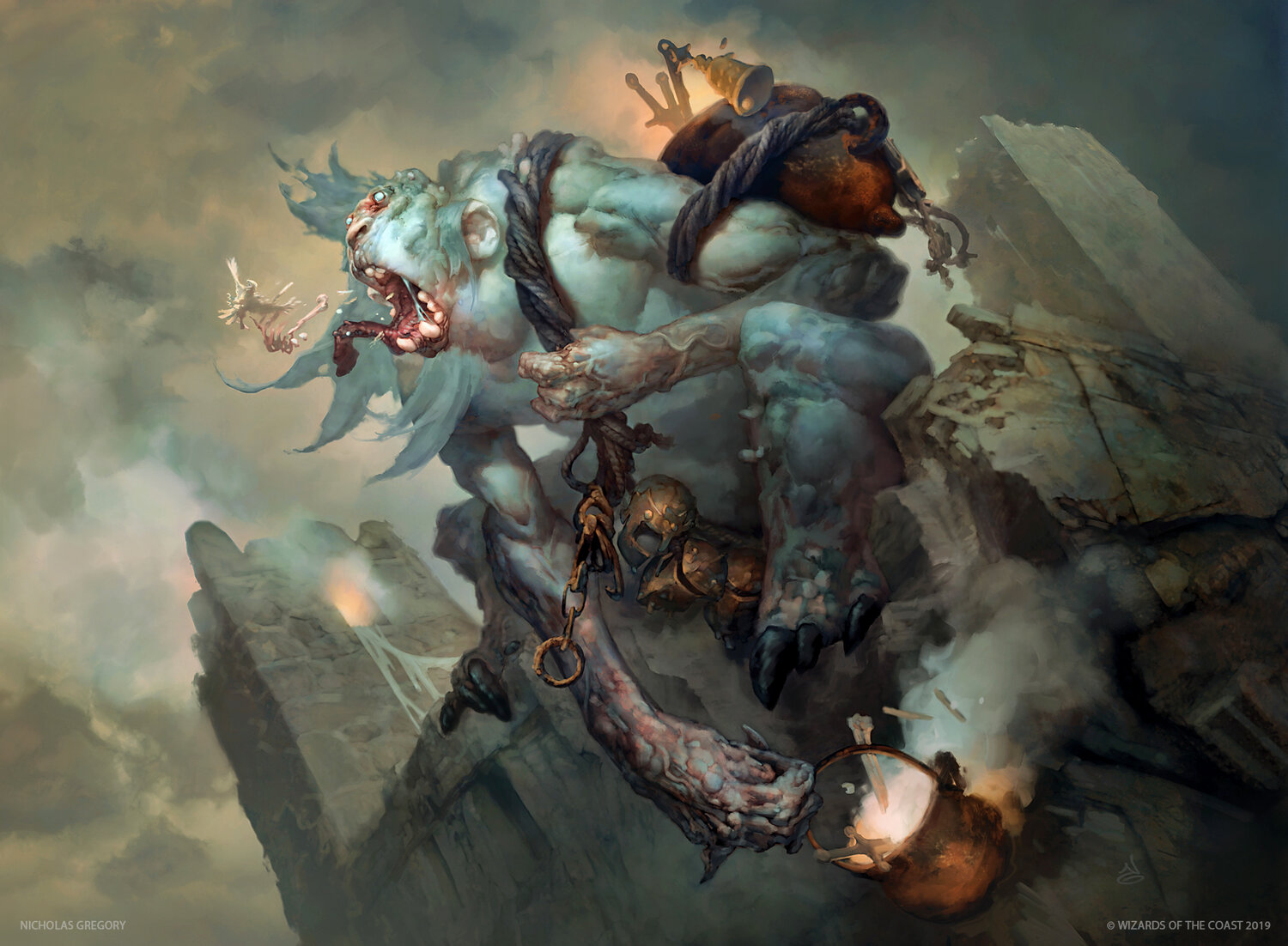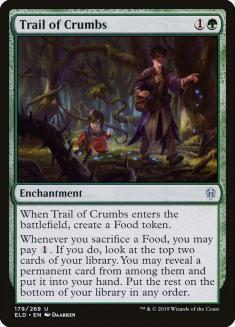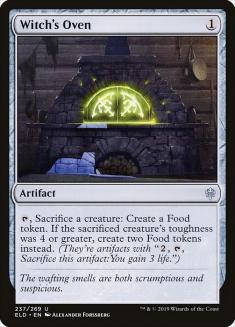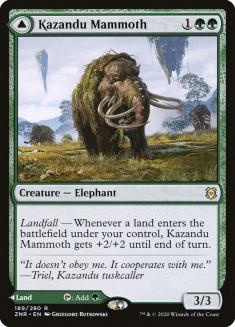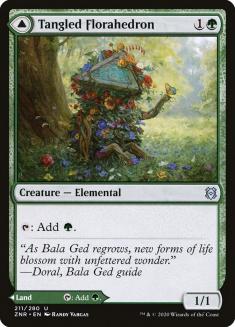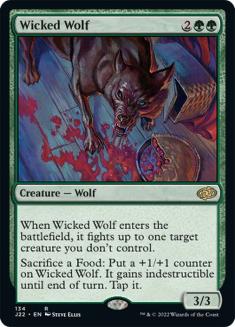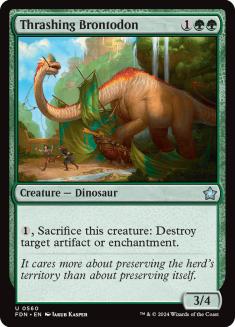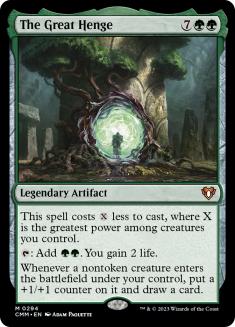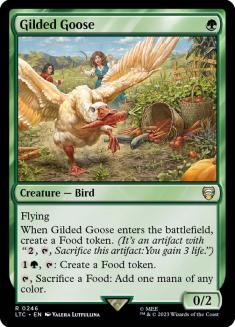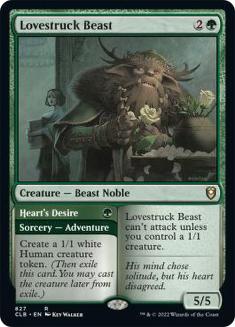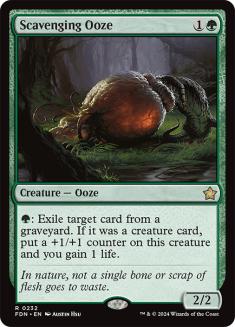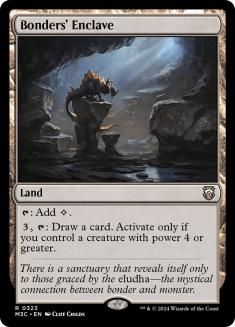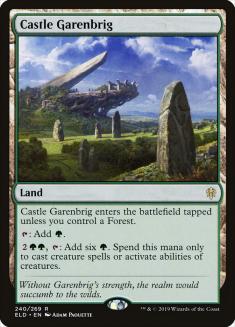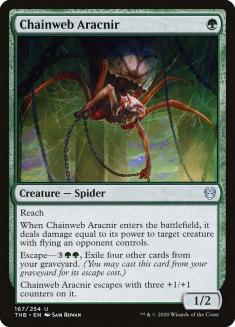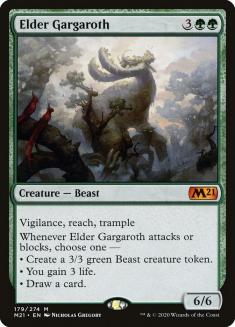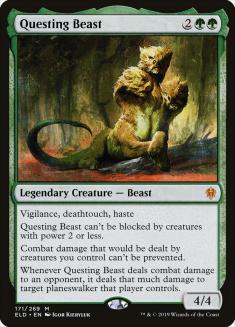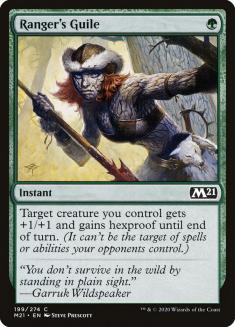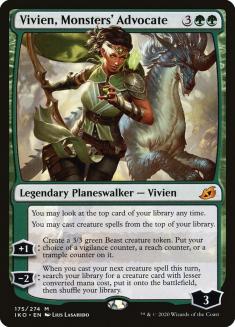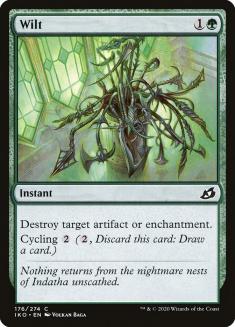Last week’s article chronicled my dive into Zendikar Rising Standard. We’re all only a few weeks removed from Omnath, Locus of Creation dominating but already we’re healing. There are so many different archetypes to choose from and so many powerful cards to build around. The gameplay is interesting, with a ton of decision making and payoffs for high synergy interactions. There’s also some flashy Rogue deck that plays like Faeries, so why am I not playing that deck?
Creatures (28)
- 2 Scavenging Ooze
- 2 Thrashing Brontodon
- 4 Gilded Goose
- 4 Lovestruck Beast
- 4 Wicked Wolf
- 4 Feasting Troll King
- 4 Tangled Florahedron
- 4 Kazandu Mammoth
Lands (6)
Spells (26)

I’ve grown quite fond of Mono-Green decks over the years. It seems like there’s always something fun to ramp into, but this deck is an entirely different animal. One of my favorite types of decks is one that revolves almost completely around some engine. In this version of Mono-Green Food, our engine is pretty clear. Our goal is to generate a ton of Food tokens and then use those in a number of ways. The biggest payoff, and the card that really makes the deck shine, is Trail of Crumbs.
It’s no secret that Trail of Crumbs is dope. It was one of the core pieces of the Cat-Oven engine in Core Set 2021 Standard and continues to help permanent-based decks flourish in such a hostile environment. I’d say we’re using Trail of Crumbs about as fairly as anyone could rightfully ask. All we find with it are more lands, more creatures, and more engine pieces. It’s an easy way to grind an opponent trying to beat you with spot removal, and singlehandedly buries any archetype playing defensively (if they don’t answer it immediately).
Trail of Crumbs, in particular, starts to do some disgusting stuff when you pair it with any number of creatures in your deck. Gilded Goose can eat a Food token and use that mana to pay for the cost of Trail of Crumbs, creating a mini-draw engine without much effort or investment. Wicked Wolf can turn any number of Food tokens into triggers just by pumping itself. Feasting Troll King can trigger Trail of Crumbs multiple times upon its return from the graveyard to the battlefield. All of your cards work well together but are also individually excellent, which ultimately makes for a great Mono-Green deck!
I’ve seen some versions of this deck, played by the likes of Chris Kvartek, that leave Witch’s Oven on the sideline. I can’t blame them. The deck already generates a ton of Food tokens without Witch’s Oven gumming up the mix. However, if your opponent is adamant about exiling your creatures with Elspeth Conquers Death or just has a ton of ways to grind you down, having that extra source of Food generation to continue the Trail of Crumbs chain can be key. My favorite thing to do is sacrifice Feasting Troll King, generating almost enough food tokens to return immediately, while providing more triggers for Trail of Crumbs!
This card is not one I love. I’ll be honest, it was a nightmare to play with and against when Cauldron Familiar was around. However, after seeing it in action without Cauldron Familiar in a variety of archetypes, I’m no longer “a hater.” Instead, I’m “a simp.”
I’ve said time and again that these DFCs are some of the best cards printed in a long time, but not in the way you might think. To me, a card like Omnath, Locus of Creation is just a miss. It’s too powerful, always gets to do “the thing,” replaces itself, and just overwhelmingly creates negative experiences for the opponent. The DFC’s are excellent because they help create dynamic gameplay while improving the consistency of your deck. It’s extremely good but in an entirely different way from something like Uro, Titan of Nature’s Wrath.
Kazandu Mammoth specifically has already seen some play in Pioneer. I’ve quite liked it in a variety of Gruul Aggro strategies, and continues to be a major player in nearly every green deck in Zendikar Rising Standard. I don’t see that changing anytime soon. However, the refreshing thing about Kazandu Mammoth is that I also can’t imagine anyone ever complaining about losing to it. Like, yeah it attacks for five once or twice a match, but it gave you some time to interact and offered both players the gift of an interactive game of Magic.
Tangled Florahedron specifically is a bit harder to judge, but I just want to say one thing: I have drawn Llanowar Elves in far too many situations where I just wanted to draw a land. A mana-producing creature having the ability to become a land when you can’t afford to have your mana Lightning Bolt’ed is a huge deal. On top of that, if you don’t have the time to actually cast a Tangled Florahedron on-curve, or because you drew it at the wrong time, you can just play it as a land to make sure you have enough mana next turn to do all the things you need.
Overall, I only see things to love about both of these cards. While there have been some major mishaps in the last few years as far as power level is concerned, I just want to say that the DFCs, outside of their interaction with Balustrade Spy / Goblin Charbelcher, have made for some of the most interesting games of Magic I’ve had in a very long time.
This baddie is secretly the second-best card in the deck (don’t tell anyone!). Ever since I started playing Mono-Green Devotion in Pioneer last year, I’ve learned just how good a fight ability can be. We haven’t really seen that effect be playable, let alone good until Voracious Hydra came on the scene. Stuff like Polukranos, World Eater doesn’t really count because that’s just a huge mana dump and completely takes over the game.
The fight mechanic has mostly appeared on spells instead of creatures. Having creatures enter and fight another opposing creature has given the ability a second chance at life. Of course, there have been giant baddies that enter and fight before, but it isn’t until recently that they’ve been cheap, and often draw the comparison to one Flametongue Kavu. Wicked Wolf in particular made waves in Standard and Pioneer when Oko, Thief of Crowns was legal. Fight on an indestructible body is a huge deal and often leads to some very nice blowouts.
Wicked Wolf is also just surprisingly hard to deal with from the opponent. If you have a Food token or two lying around, chances are that your Wicked Wolf won’t be leaving the battlefield unless Elspeth Conquers Death decides to show up. It attacks, it blocks, and your opponent has no real way to fight back unless they can exile it or fly over it. The fact that it works so well with Trail of Crumbs is just a juicy coincidence.
Not a flashy one, but one that’s very important to discuss. If you noticed in the deck I wrote about last week, cards that destroy artifacts can be incredibly useful at the moment (we’re playing Shredded Sails for crying out loud). Thrashing Brontodon can do that too while also providing the caster with a 3/4 body for just three mana! An answer to Embercleave that can block their early creatures or apply some pressure is a huge deal, and four toughness is often very tricky for them to deal with until after sideboard.
Thrashing Brontodon is just the card we “have” to play so we don’t lose to The Great Henge or Embercleave too much. If they draw one of those cards and cast it before you have Thrashing Brontodon or one of your own, chances are you’re not going to win the game. Those artifacts are absolutely, positively broken.
Well speak of the devil and it shall appear. The Great Henge is the second engine that makes this deck function behind Trail of Crumbs. We don’t have a thousand creatures to spam the battlefield with, but The Great Henge generates a ton of card advantage, battlefield advantage, and some much-needed life points on occasion. The Great Henge is one card that Ugin, the Spirit Dragon has trouble beating because they almost always have to minus to clear the battlefield, but that leaves them fighting an uphill battle against The Great Henge.
I’m not a scientist, but it seems like the person who resolves one of these expensive, powerful artifacts has a good shot at winning the game. That said, they are legendary, so playing more than two or three comes with a price. Drawing two is almost always horrid and drawing three is likely a death sentence.
I don’t want to carry on too much about The Great Henge, but I’ve loved it for a year, and I’m glad it finally has a good home in Standard.
“You’re the worst mana accelerator I’ve ever heard of.”
“But you have heard of me!”
I hate Gilded Goose. I mean, given the right circumstances, it’s excellent with your other Food generators and payoffs, but it’s complete garbage at mana acceleration. It’s so hard to compare to other mana accelerators because you can’t really do it every turn, and there’s very little reason for a deck like this to ramp into a three-drop. So why are we playing it?
If you ever got to play with Deathrite Shaman when we didn’t have fetchlands, you’ll know what I’m talking about here. It’s obviously a powerful card that can singlehandedly bail you out of weird games. Generating a Food token every turn to eat and gain life while fueling Trail of Crumbs or whatever is tops, but it doesn’t exactly do the “mana accelerator” thing as well as its predecessors. And that’s okay. Not everything needs to be on the same level as Llanowar Elves.
Love it or hate it, Lovestruck Beast has become a staple in green decks across almost every Constructed format. It’s so large for such a small amount of mana and generates an extra body along the way. All you need to do is make sure you have a puny 1/1 lying around somewhere, which isn’t too hard to do. Tangled Florahedron helps a little, but Lovestruck Beast is a self-fulfilling prophecy on most occasions in this archetype. It’s maybe at its worst in this deck because we don’t have many other ways to fuel its attack, but it’s still an absurdly large blocker against some of our tougher matchups and we’re Crumby enough to find a Tangled Florahedron or backup Lovestruck Beast when needed.
Toss in a little Scavenging Ooze and you’ve got yourself a stew goin’!
I wanted to talk about this land specifically because I see a lot of people jamming three or four into their decks. I think running two copies is almost free, but three is pushing it. I’ve been thinking about cutting it to one or zero because I just don’t use it often enough. With how mana-intensive things like Gilded Goose and Trail of Crumbs are, I find myself rarely having enough mana to draw a single card. However, it’s nice that the effect is coming from a land instead of a spell.
Castle Locthwain this is not.
We haven’t seen this one much lately, but Castle Garenbrig and I are homies. In Pioneer, I got to slam giant Voracious Hydras a turn early, often using the mana from Castle Garenbrig for exactsies. Here, we’re using it to accelerate into exactly Feasting Troll King. The end.
Best card in Magic by a lot. Islands, don’t @ me.
The Sideboard
Before we get too deep into it, I just want to say that this sideboard is a masterpiece. Every single card is multi-use in more than one matchup. Rare is it that all parts of the sideboard get used in a five-match set. Here, I feel like we’re able to fluidly sideboard out our engines and expensive cards against aggro while making sure we have enough heavy hitters and Naturalizes to fend off some of the weirder stuff being thrown at us.
When you play only one color, chances are that your sideboard will be weaker on average than that of a multicolor deck. It’s natural, as playing more colors just gives you access to a wider variety of spells. With green being given a huge power boost over the last few years, I don’t think that’s the case here. We can answer a variety of problems, pose a significant number of unique threats, and even protect ourselves against some annoying instances of spot removal. Let’s take a peek!
This one’s a bit straightforward. It’s a cheap tool for interacting with Dimir Rogues in the early turns. It can trade with some of their smaller creatures or removal while posing as a cumbersome obstacle in the later turns. It is by no means a slam dunk against the matchup, but there are few cards I’d rather see on my side of the battlefield than Chainweb Aracnir. It slices, it dices, it can even take your mother out to dinner if you ask it nicely.
It’s not great in multiples, so we don’t want to go overboard. Plus, you have the freeroll of getting it milled into your graveyard so you’ll be using escape more often than casting the front half. We’re just using their strength against them!
A solid body against any non-Embercleave draw from aggro decks, Elder Gargaroth slays. The fact that you get the effect on attack and block means your opponent needs to remove it before swinging which turns out is kinda hard to do. I love that you can generate a 3/3 body when you need some more pressure or defense, but the fact that you can draw a card when you need something more specific or just gain some life to put yourself out of burn range is such a slam dunk. The only reason we’re not playing it maindeck is because it doesn’t match up well in The Great Henge mirror and isn’t so hot against Esper Doom Foretold (Yorion).
You know your Mono-Green deck is good when it doesn’t even want Questing Beast in the maindeck! We’re all about synergy baby, but sometimes you need to give ’em the beatdown. Questing Beast is your big threat against slower strategies, and especially any that just so happen to be running planeswalkers at the moment. Since those are few and far between, Questing Beast isn’t at its best right now.
If you aren’t going aggro full-tilt, Questing Beast probably shouldn’t be in your maindeck, but that doesn’t mean it can’t be a handy sideboard tool!
An absolute beating, Ranger’s Guile is your answer to Elspeth Conquers Death and usually just ends the game on the spot. Sometimes you just need one turn to protect your Feasting Troll King so it can nom on your opponent’s life total. Ranger’s Guile is also straight-up deadly against any opponent trying to kill your creatures with normal spot removal. If they’re on the slower side of the spectrum, try bringing this in. It will lead to some very easy dubs.
And Scavenging Ooze was there too!
While it won’t shatter the game like Nissa, Who Shakes the World, Vivien, Monsters’ Advocate is a fine planeswalker in her own right. She creates pressure and can lead to some overwhelming turns when combined with The Great Henge or even Trail of Crumbs given enough mana. Our deck generates a ton of mana and hits just about every land drop for the entire game so I think Vivien can be excellent in any matchup where you have time.
This is the classic “sideboard threat that’s hard to kill” card for a linear deck. In the past, we’ve played all sorts of spells in this slot, but the green planeswalker we have at the moment just so happens to be pretty damn good. I wouldn’t be surprised to see this one show up in maindecks more often. I just don’t think it’s all that necessary, and it seems quite bad against Gruul Adventures.
These two are just backup Naturalize effects for matchups where you really need them. The mirror is starting to grow in popularity, so I highly recommend loading up if you can. I might even try to get one or two copies of Kogla, the Titan Ape in the 75 to help keep all those pesky opposing copies of Trail of Crumbs in check. I like Wilt because it feels a bit better against Embercleave specifically, but it’s possible that Kogla is just the better option.
Food for Thought
It’s pretty incredible to me that Feasting Troll King is finally a good card in Standard. When it first debuted, I tried it out in an Oko, Thief of Crowns deck. After all, generating a bunch of Food is a great way to keep bringing back this big baddie. When my opponent cast a Feast Troll King of their own, and I got to simply tick up my Oko to handle it permanently, I knew something was very wrong. I’m glad Oko, and a number of other problematic cards, have been removed from Standard so that something as synergy-driven and clunky actually gets to be good!
I often find Limited Magic to be fun because you see the full potential of lesser-played cards. In Constructed, you just don’t get to see some of the weaker cards shine because the flashy mythic rares they’ve buried us with over the last two years hog the spotlight. It might have taken sixteen bans and altering the rules of a broken mechanic, but that’s it. We’re here and the water’s just fine.

